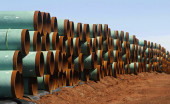Johannah Bernstein post: "eternally proud of my father’s extraordinary aeronautical engineering. legacy. here is a photo of the Canadair Water…
Tar sands: Canada’s next vacation wonderland?
Written by Diana Thebaud Nicholson // June 26, 2008 // Media, Oil & gas // Comments Off on Tar sands: Canada’s next vacation wonderland?
26 June 2008
 TravellingAlberta.com offers one-of-a-kind oil sands vacation packages
TravellingAlberta.com offers one-of-a-kind oil sands vacation packages
As the Canadian Association of Petroleum Producers (CAPP) embarks on a synchronized propaganda campaign aligned with the Province’s “rebranding” of the tar sands, Greenpeace has launched its own website to counter the greenwashing.
Brilliant move by Greenpeace. Bravo!
Oil sands: Canada’s next vacation wonderland?
(Reuters) If it’s sand you crave on your vacation, then Greenpeace might have just the travel idea for you.
But you could have some hefty cleaning bills by the time you get home.
In an increasingly heated debate over the ecological impact of Canadian oil sands production, the environmental group has launched a tongue-in-cheek website promoting the huge northern Alberta energy projects as vacation destinations.
Using Alberta’s logo, the site, www.travellingalberta.com, invites tourists to laze on black-sand beaches surrounding tailings ponds, hang-glide on “the unique coal bed methane and sour gas updrafts,” then ride on one of the gargantuan dump trucks that trundle around the oil sands mines.
“Welcome to Alberta. Canada’s Rocky Mountain Playground – a carbon-based energy powerhouse!” the site says.
Greenpeace, one of several groups that have seized on the environmental impact of booming oil sands development, developed the site in response to public relations campaigns by the Alberta government and the oil industry, Mike Hudema, its tar sands campaigner, said Thursday.
Earlier this year, Alberta Premier Ed Stelmach announced a $25 million (US$24.7 million) communications push to protect Alberta’s “brand” and “perception” around the world from environmental critics.
This week, the Canadian Association of Petroleum Producers launched its own site (http://www.capp.ca/oilsands/Pages/default.aspx) to get its message out that oil sands producers are doing all they can to cut greenhouse gas emissions, lower water use and limit damage to the northern forest, and are willing to discuss issues with the public.
“Both of those are really giving a very limited picture of what the tar sands are, so we decided to launch this site to add a little bit of humor to the discussion, but also show the other side of the picture, which is definitely not a very pretty one,” Hudema said.
Alberta’s oil sands rival Saudi Arabia’s conventional oil reserves in size and oil companies, prompted by record crude prices and shrinking opportunities in other countries, are rushing to develop the unconventional crude to meet North American demand for secure energy supplies.
CAPP was not amused by the bogus tourism campaign.
“I think industry is more focused on the serious issues,” Travis Davis, a spokesman for the association, said.
Alberta Tourism Minister Cindy Ady said she was disappointed in the website because it gives an inaccurate impression of the province, also known for its mountains and Western culture.
“I think the millions of people who come to visit us here have seen it, and know it, and we don’t have anything to apologize for. We have some of the most stunning vistas in the world,” Ady said.
On a more serious note, the message is clear:
“When you visit the Alberta tar sands you won’t find a relaxing natural environment. Instead, you’ll be in the midst of one of the biggest environmental disasters threatening the world today. It’s an ongoing disaster, actively promoted by the energy sector and elected leaders who put short-sighted economics ahead of the interests of people and the planet.
Tar sands operations consume vast amounts of natural resources to extract and process over a million barrels of oil per day. In all, over 140,000 sq km is on the chopping block — an area larger than the state of Florida. The tar sands are the dirtiest, most energy intensive source of oil on the planet.
In exchange for oil, Alberta is left with a threatened ecosystem of massive proportions and no signs of improvement. Run-away development severely strains the social infrastructure. Reports document cancer-related deaths downstream of the tar sands operations in communities like Fort Chipewyan.
Pollution of air and water, depletion of resources, destruction of pristine boreal forests, displaced wildlife, health and social effects on local communities and the very real impact on climate change — this is the legacy of the tar sands.
But it’s not too late. If enough people speak up against the expansion and destruction, we can stop the tar sands.
Do your part to help.
- Learn more about the tar sands.
- Let friends and family know.
- Tell Alberta Tourism operators, Alberta’s Premier, and Prime Minister Stephen Harper that it’s time to put the brakes to the Alberta tar sands.


